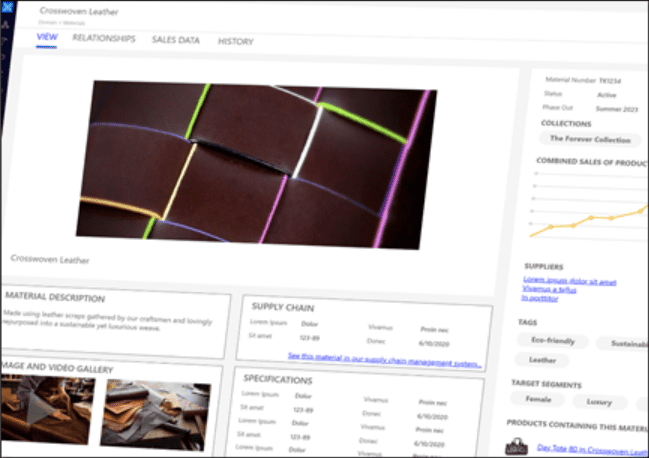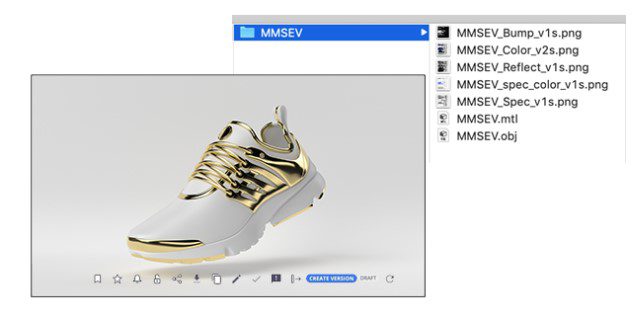A new approach
Imagine combining Digital Asset Management (DAM) and Product Information Management (PIM) in a dynamic, API-first system that is meant to be adapted to your unique business processes. What you end up with is a new approach-one that breaks down silos, helps you to spot emerging trends, and ultimately helps you to bring new products to market faster or with less effort. This is Product Asset Management (PAM).
When staff such as marketers and product designers can access all the company’s product information-including digital assets-in one system they can begin to see the links between records and spot emerging trends.
Marketer
For example, imagine a marketer who is responsible for managing some of the company’s relationships with influencers and celebrities. She is looking at a page in the PAM system that is dedicated to one of the celebrities that helps to promote certain of these products. She can see the images and videos that the company has of this celebrity, including both photoshoot shots and less-formal social media content. She can also see which products the celebrity is affiliated with and see when the celebrity’s current contract ends. If the company is bringing sales data into the PAM system, she can even see the aggregate sales trend across all of the products promoted by this particular celebrity.
The marketer may start to click into the various products promoted by this celebrity to see detailed information about each of these products. Clicking further, she might even look at the materials, in the materials library, that are featured in these products. Perhaps she notices that the products with the highest sales or best margins, among those promoted by this celebrity, all feature a certain sustainable or up-cycled material that the company promotes. She remembers that this celebrity has an affinity for sustainability, and makes a note to talk to their agent about having them promote more of the company’s products that use this particular material. She may even think to suggest to the product design team to consider developing a product with this material specifically for this celebrity to promote.
Product designer
The product designers may start from a different place in the system but come to a similar conclusion. For example, a product designer (or design team) might be looking for new ideas for next season (for the sake of this example, let’s imagine this is a company that produces apparel or accessories, such as purses). And again, let’s assume that we’re bringing sales data into the PAM system, either via a continuous API connection or via daily or weekly data imports. By using this system that pulls in data from the company’s other systems, the team is able to see the same information that the marketers can see. They may look for products or materials that are trending, or even look at other traits that trending products are tagged with (for example, “interior smartphone pocket”).
Let’s say that this team also notices that products with a certain sustainable or up-cycled material are trending. They click to the materials page and can see both the manufacturing specifications (pulled in from the company’s supply-chain management system), but also have the texture file as well as photos of the material in different products. They see, for example, that the material is currently being used in larger handbags and purses with higher price points, but it has not yet been tried in smaller items, like clutches.
From idea, to design, to launch
At this point, this particular designer or design team decides to propose a smaller item using this material. They create a product page in a draft or design folder in the system and start tagging it with attributes and materials. At the same time, they use their 3D design software to start drafting up designs. As each draft is produced, they upload the 3D files to the system. 3D digital assets are typically composite assets, meaning that they typically consist of multiple files. Unlike a pure PIM, the PAM system is able to handle these composite 3D digital assets in order to properly create pannable, rotatable previews.
Having 3D integrated into the design workflow creates a number of advantages:
- It is easier for designers to demo the initial concept (for example, to marketers, executives, focus groups, and other designers) if even the rough initial mockups are 3D and can be rotated, panned, and zoomed.
- The designer themselves can visualize things in 3D, such as space requirements; the best places to put things like screws, weld marks, or stitching; the visual impact of different material and feature options; and overall look and feel, that they wouldn’t necessarily see as easily in 2D.
- It reduces the need to create multiple 2D views. (And, in cases where those views are still needed, they can often be generated from the 3D model)
- A 3D model can be virtually placed in a physical space. Even prior to prototyping a designer or marketer can use image editing software (or even augmented reality glasses) to create visuals for how a product could look in a home or a showroom. Customers are starting to use augmented reality apps to see how, for example, a piece of furniture might look in their homes.
- Some prototypes can be created using 3D printing. This can drastically improve the efficiency of the prototyping process. Even in cases where 3D printing cannot be used, the use of 3D assets can vastly improve communications with the people producing the prototype.
- Rotatable 3D product photos are becoming a key part of ecommerce experiences. Additionally, 3D models can be an important part of an end-user experience that allows customers to customize the product that they wish to buy.
The team is able to collaborate with others by directing them to the correct link within the PAM or by using custom workflows that allow others to provide comments or annotations. The system will track the versions of the draft product asset as the team goes through different iterations of the design.
Once the design team is satisfied with their initial designs, they are ready to commission prototypes. Rather than relying on emails back and forth with the factory, they are able to request prototypes in a much more trackable way by clicking a “Request prototypes” button right on their draft product page, which allows them to fill out a form that executes a workflow. This then creates a trackable task for the prototype team or the factory.
Once the product design is approved, the marketers begin creating the digital assets. This is another place where we see how PAM outshines traditional product information management. The marketing team is able to pull the 3D assets for this product from the system to re-purpose them for use in ecommerce. They are also able to use the system’s photo studio workflows to commission photo and video shoots using the prototypes, and, once those photos are uploaded into the system, they are able to choose their selects, annotate them, and send them through for touch-ups and color correction.
Those digital assets are then available in the system to pull into campaigns, and once the product is launched, the cycle begins again.
Want more information?
iSoftStone has deep experience around Content Services Platforms. Or, connect with a subject matter expert today to learn more.








